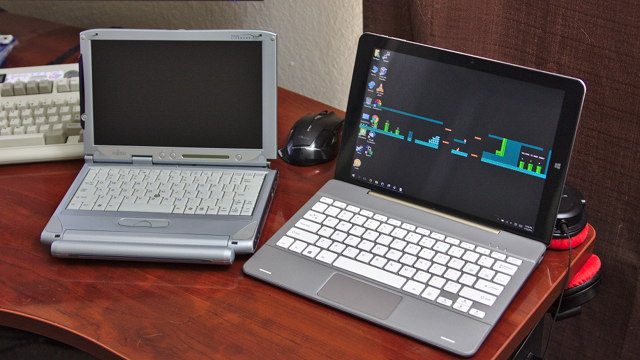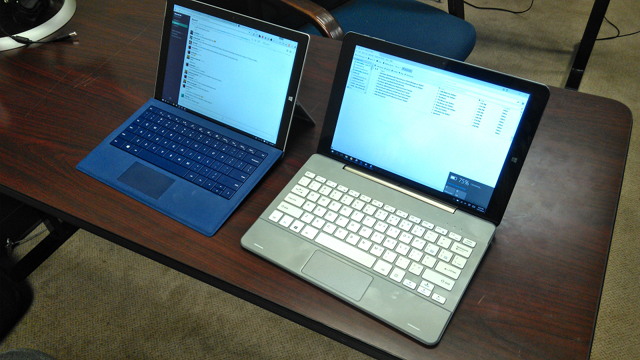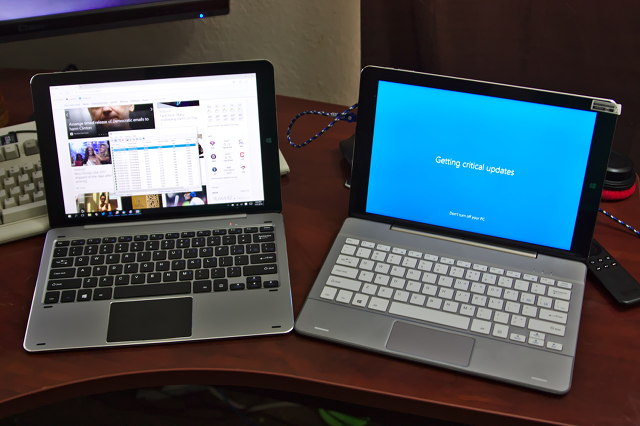I’ve been using the same laptop for more than six years. It is a giant laptop with an 18.4” screen, and it weighs nearly ten pounds. When I bought it, it was a desktop replacement, and its quad core i7 processor is still just as fast as any of the ultrabooks I’ve been interested in—like my friend Brian’s Dell XPS 13.

The big laptop is nice when I travel, because I often end up setting it up on a desk somewhere at my destination, and it sits there for most of the duration of my trip. Lately, though, I’ve been lugging my heavy laptop bag to TheLab.ms makerspace several times each week, so I’ve been feeling the need for a more portable laptop.
More than a decade ago, I owned a Fujitsu P2120. It was an expensive, business-grade, netbook-size laptop from the days before inexpensive netbooks even existed. It was small, light, and it would run for 10 hours on a single charge. I was hoping to recreate that experience with modern hardware, and without spending $2,500 like I did in 2003.
In the size and weight range I was interested in, there are quite a few tablets with keyboards and kickstands—like the HP Spectre x2 and Surface Pro 3—but I don’t like these kickstands. I wanted something that I could comfortably use in my lap. I don’t want to skip ahead too far, but I’m writing this blog post in my office while sitting in my big recliner with my Chuwi Hi12 on my lap.
I had quite a few requirements on my wishlist, and the Chuwi Hi12 did a good job of meeting most of them.
- 12” or 13” screen
- Tablet with a keyboard dock
- No kickstands!
- x86 CPU
- As much RAM as possible
- Linux support
What else did I look at besides the Chuwi Hi12?
One of the most obvious choices is the Surface Pro 3. Although it is a nice piece of hardware, it starts at closer to $900—three times more than I paid for my Chuwi Hi12—and the odds of ever running Linux on the Surface seem pretty low. I’d be willing to pay $1,000 or more for a higher-end device, but not if I’m stuck running Windows 10.
The HP Spectre x2 looks like a decent piece of hardware, and it sure looks like it should be easy enough to get Ubuntu running on it. Unfortunately, the Spectre is another tablet with a kickstand and a flappy keyboard.
| Chuwi Hi12 | Surface Pro 3 | Dell XPS 13 | ASUS Chromebook | |
|---|---|---|---|---|
| RAM | 4 GB | 4 GB | 8 GB | 4 GB |
| CPU | Atom Z8300 | i3-4020Y(?) | i5-6200u | Dual Core 2.16 Ghz |
| Storage | 64 GB | 128 GB | 128 GB | 16 GB |
| Display | 12.2” 2160x1440 |
12.2” 2160x1440 |
13.3” 1920x1080 |
13.3” 1920x1080 |
| Tablet Weight | 1.88 lbs | 1.76 lbs | n/a | n/a |
| Keyboard Weight | 1.88 lbs | 0.58 lbs | n/a | n/a |
| Total Weight | 3.76 lbs | 2.34 lbs | 2.6 lbs | 3.1 lbs |
| Price | $280 to $380 | $800 | $869 | $270 |
On the more inexpensive end, I looked at some of the Asus Transformer tablets. ASUS actually has tablets with keyboard docks similar to the Chuwi Hi12. They just don’t quite meet the specs of the Chuwi. The most reasonably priced Transformer tablets have less RAM than the Chuwi, and the 12” Transformers have smaller, low resolution, 16:9 aspect ratio screens.
I also looked at some Chromebooks. They don’t exactly meet my needs, but they are at least light and inexpensive. I included one in my features table for the sake of completeness.
Let’s talk about the Chuwi Hi12
The Chuwi Hi12 is a compromise, but I can definitely say that it is an interesting compromise. It is easy to compare it to the Surface Pro 3 and dismiss the Chuwi Hi12 because of its underpowered processor. I don’t look at it this way.
The Chuwi Hi12 is priced competitively with 13-inch Chromebooks, but the Chuwi has a full operating system, the same beautiful screen as the Surface Pro 3, and it is a 2-in-1 tablet to boot. It is a fantastic piece of hardware for this price point!

The keyboard really sealed the deal for me—especially if you get the new version of the Chuwi Hi12 keyboard. I only had my Chuwi Hi12 for a couple of days before we had to order one for my wife. Hers came with a different keyboard—one I hadn’t seen in any reviews yet.
My older Chuwi keyboard has a narrow touchpad. The newer model has pushed the keys closer to the screen to make room for a regular-size touchpad, and in doing so they also created a more comfortable area to rest your wrists. The keys on the new-style keyboard feel a little better, and it is slightly thinner than the original, but it makes more noise when I type.
I read quite a few reviews before purchasing our first Chuwi Hi12. Most of them agreed that the keyboard is excellent, while the touchpad is garbage. I’m not a fan of any touchpad, but they’re correct—that narrow touchpad on the original keyboard is pretty crummy. The new touchpad is a huge improvement.
The Chuwi Hi12 keyboard closely matches the dimensions of my IBM Model M keyboard.
- Chuwi Hi12 at Amazon
- Chuwi Hi12 at Gearbest ($219.99 with code CHi12)
I’m embarrassed to be running Windows 10
I haven’t had Windows on any of my home computers since the days when I dual booted Windows 95 on my old Cyrix P200. I actually avoided the Chuwi Hi12 for months because I wasn’t interested in carrying a Windows laptop.
I’m treating this more like an appliance—a web-browsing machine that happens to run Emacs. I hope it won’t be too many months before I can switch to Linux. It sounds like Ubuntu boots just fine, but the drivers for the touch screen, accelerometer, and sound card aren’t working correctly.
For now, I’m just pleased that I don’t have to carry a 10-pound laptop, and an even heavier bag.
Upgrade the video driver!
Shortly after Windows 10 downloaded and installed the first batch of updates, my Chuwi tablet was crashing a lot. Almost every time it crashed was after putting it to sleep. I updated the Intel video driver, and it hasn’t been a problem since.
Just how heavy is the Chuwi Hi12?
At about 1.8 pounds, the Chuwi Hi12 tablet isn’t more than a few ounces heavier than the Surface Pro 3, but the keyboard is a different story. My friend Sam carries a Surface Pro 3, and when I handed him the folded-up Chuwi Hi12, he just said it was way too heavy!

I expected this would be the case, and it is a trade-off I’m more than happy to make. The Chuwi keyboard has to have some mass to it, or else the weight of the tablet would make it unstable in “laptop mode.” I’m willing to carry a little extra weight, especially if it means I can easily use my laptop in my lap.
The tablet-and-keyboard combo weighs a total of 3.5 pounds. That’s less than a pound heavier than my friend Brian’s Dell XPS 13. Speaking of the XPS 13, if you’ve seen one, you know roughly how big the Chuwi Hi12 is. Brian’s laptop is a hair thinner than my folded up 2-in-1, but the other dimensions are quite close. Of course, the XPS 13 has that bigger InfinityEdge display!
I needed to find a bag!
I still have an old Dell bag that my Fujitsu P2120 used to call home. It is only just barely big enough for the Chuwi Hi12. Most of the time, I expect to walk out of the house with only the Chuwi. When I do take the bag, I’d like to have room for a little more than just the power cable.
I ended up buying the AmazonBasics 11.6-inch laptop bag. The Chuwi Hi12 fits perfectly, and it has two additional zippered pockets to store all my extra gear. It also has a shoulder strap—something my old Dell bag was lacking.
As usual, I packed the bag with enough gear that its bulging at the seams. Even so, the total weight of the fully loaded bag is less than six pounds. That’s more than three pounds lighter than my old 18.4” laptop, and I can even fit the new bag inside my old bag—even with the old laptop and all my old gear!
- AmazonBasics 11.6 Inch Laptop Bag at Amazon
Is the Chuwi’s little Z8300 Atom processor fast enough?
Fast enough for what? My old i7 laptop is almost three times faster and has four times more RAM than my little Chuwi Hi12. In other words, the Chuwi isn’t a screamer, but it does well enough at the tasks I’m willing to tackle on a 12” display.
I was stubborn at first. I tried to use Mozilla Firefox—just like I do on all my other machines. I thought it would be more convenient to have access to all my browser extensions and synchronized bookmarks.
Don’t even bother. Just use Microsoft Edge. It feels infinitely more responsive than Firefox on an underpowered machine like the Chuwi Hi12, and it supports proper tablet-style pinch-to-zoom. Firefox just scales in 10% increments when you pinch the screen, and it does so at a glacial pace!
I’m happy enough with the performance of the Chuwi Hi12 for my use case—web browsing, email, text editing, and some light gaming. Steam streaming works about as well as it does on my Steam Link over Wi-Fi, too!
Where can you buy the Chuwi Hi12?
You can’t get one at your local Best Buy. I bought the first Chuwi Hi12 and keyboard from Gearbest for about $280. They estimated that it would take nearly a month for my tablet to arrive at my door, but it only took about two weeks. That’s still a long time, and I worried about whether or not the tablet would actually make it to my door.
We ordered our second tablet from Amazon. The tablet-and-keyboard combo was $360 with Prime shipping. The pricing at both Amazon and Gearbest seem to fluctuate quite a bit, too. The Chuwi Hi12 is still a great value at $360, and the extra $80 wasn’t a waste. It was nice not having to wait two weeks for the package to arrive, and it was a comfort knowing how quickly and easily Amazon will resolve any shipping issues.
You can also find the Chuwi tablet on eBay—usually somewhere in between the prices at Gearbest and Amazon. I haven’t bought a Chuwi Hi12 from eBay, but it is definitely a good place to look.
- Chuwi Hi12 at Amazon
- Chuwi Hi12 at Gearbest ($219.99 with code CHi12)
Charging your Chuwi Hi12
The Chuwi Hi12 comes with a 3-amp USB charger. I wanted a long charging cable for my bag, but I know that as cables get longer, their charging efficiency drops. I found a 10’ USB cable with nylon braiding for a reasonable price at Amazon. It had good reviews, but I didn’t trust those reviews, and I was curious how the USB cables I have around the house stacked up, so I also bought a USB power meter to test all my cables.
The results of my tests were surprising to me, and I’ll definitely be gathering my data and writing up a blog post. For this post, I think it is enough to say that the Volutz cables are some of the best cables I own. I liked the 10’ Volutz USB cable so much that I ended up ordering their assorted 5-pack as well.
I also picked up a compact USB charger to keep in my laptop bag. It folds up for easy storage, and the RAVPower 24W charger has a pair of 2.4-amp USB ports, so I can quickly charge my phone and tablet at the same time.
- Volutz 10 Foot Nylon Braided USB Cable at Amazon
- Volutz Assorted Nylon Braided USB Cables at Amazon
- GTT Digital Amp and Voltage Meter at Amazon
- RAVPower 24W USB Wall Charger at Amazon
What about other Chuwi tablets?
Chuwi manufactures a wide array of tablets with Intel Z8300 processors with 8”, 10”, and 12” displays. Their 8” inch tablet can be had for as little as $80, but it only has 2 GB of RAM.
The Chuwi Hi10 is a very interesting machine, though. The specs are almost identical to my Chuwi Hi12, except it has a 10” 1920x1200 screen and a less-awesome-looking keyboard. I’ve seen the price on the Chuwi Hi10 with the keyboard dock drop as low as $180.
The Chuwi Hi10 is comparable to the 10” Microsoft Surface 3 tablet, but it sells for less than half the price.
In my opinion, the two best features of my Chuwi Hi12 are the keyboard dock and the screen. I’m more than happy to pay for the upgrade over the Chuwi Hi10.
The verdict
I’m extremely pleased with the Chuwi Hi12. I expected to qualify most of my statements about the Chuwi with “for the price,” but for the most part, I didn’t have to. It may not be up to Apple’s standards, but the build quality is better than some laptops I’ve owned—certainly better than most budget laptops.
The Chuwi Hi12 tablet is a low-end Ultrabook for the price of a Chromebook. That’s a bit of an oxymoron, since Ultrabooks are defined as high-end subnotebooks. Even so, I still say it is a good description of what the Chuwi Hi12 is.
If the hardware specs of the Chuwi Hi12 fit your use case, I just can’t recommend it highly enough. I’ve bought three so far—one for me, one for my wife, and one for my father-in-law. They’re all working great, and everyone we show the Chuwi to ends up finding it fascinating.
You can use the Gearbest coupon codes to save yourself a few dollars.
- Chuwi Hi12 at Amazon
- Chuwi Hi12 at Gearbest ($219.99 with code CHi12)
- Chuwi Hi12 Keyboard at Gearbest (coupon code MPCK)
- Chuwi Hi10 Tablet and Keyboard
- AmazonBasics 11.6 Inch Laptop Bag at Amazon